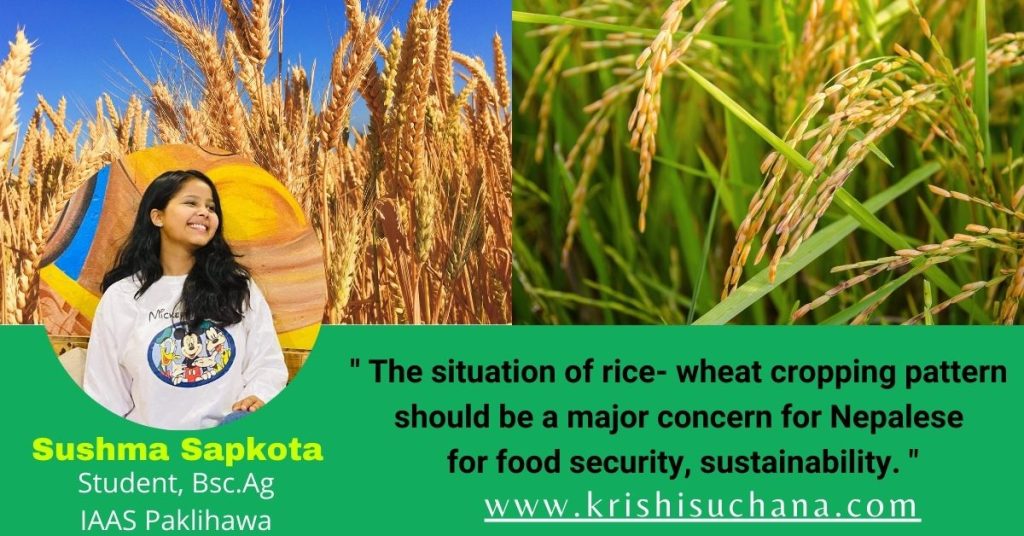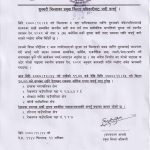Rice Wheat Cropping Pattern

Situation and Solution
In Nepal, rice based and rice wheat cropping is the most practiced farming system. It covers about 37% of rice growing and 85% of wheat growing in the country. Rice alone contributes to 20% of the agriculture GDP of the country and 53% of total cereal production in Nepal including one third of total calorie intake of Nepalese population. However, this cropping pattern have significant differences in field preparation techniques and water management system raising a certain concern in its present situation and future.
In recent years, the yield of rice and wheat seems to be decreasing although efforts are made to increase productivity to meet national production requirements. Long duration varieties of rice mature lately and provide less time around for seed bed preparation in wheat, forcing farmers for late sowing of wheat. Late planted wheat and long duration varieties of wheat get hit by rainfall during harvesting time ultimately damaging the production.
Excessive application of synthetic fertilizers and other agrochemicals in the rice wheat system deteriorates the ground quality through runoff and leaching of chemical residues to ground polluting water for human consumption and agricultural application ultimately causing a threat to crop health along with human and livestock. Soil undergoes major physical, chemical and biological changes throughout every cycle of rice-wheat cropping. Organic matter decreases gradually. Puddling done for rice changes the soil structure forming a hard structure. Due to which it will be difficult for wheat cultivation and tillage should be done. Each year due to cultivation of this pattern soil productivity is decreasing due to which yield cannot be sustainable.
The real question is what can be done? This farming system needs to promote maintenance of permanent soil cover, minimum soil disturbance and diversification. The long-term benefits to soil health and the entire agroecosystem are vital for our food security.
Zero tillage: Here, seeds are directly placed in required depth and spacing, this brings positive changes in soil properties, microfauna, microflora and long-term crop productivity.
Crop rotation: Replacing rice with legume or green manure crops for a season can increase sustainability. Legumes such as cowpea, mungbean increase yield of both crops significantly compared to simultaneously rice wheat. Some crop rotations such as: rice- (wheat + legume), rice wheat-rice bean, rice+ legume (in bund)- wheat.
Soil organic cover: Both rice and wheat are high nutrient requiring crops. Practicing this cropping pattern causes huge decrease in organic and inorganic matter of soil. Applying farmyard manure, green manure crops are effective.
Alternate wetting and drying: it is a technique developed by an international rice research institute. its main aim is to maintain optimum water level at any stage of crop growth.
The situation of rice- wheat cropping pattern should be a major concern for us Nepalese for food security, sustainability; different principles of crop rotation, zero tillage, alternate wetting and drying should be applied sooner to preserve soil, environment impact. Rice wheat cropping system alone occupies more than 50% cropping area hence, various aspects and changes yet to be made for sustainable food security.

 एउटा यस्तो विषालु भ्यागुता, जसको मुल्य नै पर्छ ३ लाख, जान्नुहाेस्
एउटा यस्तो विषालु भ्यागुता, जसको मुल्य नै पर्छ ३ लाख, जान्नुहाेस्  भोलि र पर्सि बालबालिकालाई भिटामिन ए खुवाइदै
भोलि र पर्सि बालबालिकालाई भिटामिन ए खुवाइदै  खगराज अधिकारी गण्डकीको मुख्यमन्त्री नियुक्त
खगराज अधिकारी गण्डकीको मुख्यमन्त्री नियुक्त  सुनसरीमा दुवै पक्षबीच सहमति, कर्फ्यु खुकुलो हुदै
सुनसरीमा दुवै पक्षबीच सहमति, कर्फ्यु खुकुलो हुदै  स्टेफेनको शतकमा आयरल्याण्ड वोल्भ्सले नेपाल ए लाई दियो २८५ रनको लक्ष्य
स्टेफेनको शतकमा आयरल्याण्ड वोल्भ्सले नेपाल ए लाई दियो २८५ रनको लक्ष्य 


